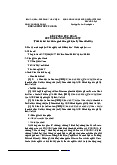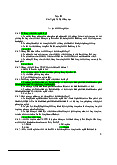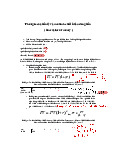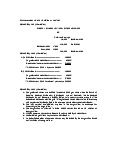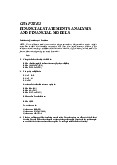












Preview text:
Exercise 1 The Falkirk Wheel
A unique engineering achievement
The Falkirk Wheel in Scotland is the world's first and only rotating boat lift. Opened in 2002, it is
central to the ambitious £84.5m Millennium Link project to restore navigability across Scotland by
reconnecting the historic waterways of the Forth & Clyde and Union Canals.
The major challenge of the project lays in the fact that the Forth & Clyde Canal is situated 35 metres
below the level of the Union Canal. Historically, the two canals had been joined near the town of
Falkirk by a sequence of 11 locks - enclosed sections of canal in which the water level could be
raised or lowered - that stepped down across a distance of 1.5 km. This had been dismantled in
1933, thereby breaking the link. When the project was launched in 1994, the British Waterways
authority were keen to create a dramatic twenty-first-century landmark which would not only be a
fitting commemoration of the Millennium, but also a lasting symbol of the economic regeneration of the region.
Numerous ideas were submitted for the project, including concepts ranging from rolling eggs to tilting
tanks, from giant seesaws to overhead monorails. The eventual winner was a plan for the huge
rotating steel boat lift which was to become The Falkirk Wheel. The unique shape of the structure is
claimed to have been inspired by various sources, both manmade and natural, most notably a Celtic
double headed axe, but also the vast turning propeller of a ship, the ribcage of a whale or the spine of a fish.
The various parts of The Falkirk Wheel were all constructed and assembled, like one giant toy
building set, at Butterley Engineering's Steelworks in Derbyshire, some 400 km from Falkirk. A team
there carefully assembled the 1,200 tonnes of steel, painstakingly fitting the pieces together to an
accuracy of just 10 mm to ensure a perfect final fit. In the summer of 2001, the structure was then
dismantled and transported on 35 lorries to Falkirk, before all being bolted back together again on
the ground, and finally lifted into position in five large sections by crane. The Wheel would need to
withstand immense and constantly changing stresses as it rotated, so to make the structure more
robust, the steel sections were bolted rather than welded together. Over 45,000 bolt holes were
matched with their bolts, and each bolt was hand-tightened.
The Wheel consists of two sets of opposing axe-shaped arms, attached about 25 metres apart to a fixed central spine.
Two diametrically opposed water-filled 'gondolas', each with a capacity of 360,000 litres, are fitted
between the ends of the arms. These gondolas always weigh the same, whether or not they are
carrying boats. This is because, according to Archimedes' principle of displacement, floating objects
displace their own weight in water. So when a boat enters a gondola, the amount of water leaving
the gondola weighs exactly the same as the boat. This keeps the Wheel balanced and so, despite its
enormous mass, it rotates through 180° in five and a half minutes while using very little power. It
takes just 1.5 kilowatt-hours (5.4 MJ) of energy to rotate the Wheel -roughly the same as boiling
eight small domestic kettles of water.
Boats needing to be lifted up enter the canal basin at the level of the Forth & Clyde Canal and then
enter the lower gondola of the Wheel. Two hydraulic steel gates are raised, so as to seal the gondola
off from the water in the canal basin. The water between the gates is then pumped out. A hydraulic
clamp, which prevents the arms of the Wheel moving while the gondola is docked, is removed,
allowing the Wheel to turn. In the central machine room an array of ten hydraulic motors then begins
to rotate the central axle. The axle connects to the outer arms of the Wheel, which begin to rotate at
a speed of 1/8 of a revolution per minute. As the wheel rotates, the gondolas are kept in the upright
position by a simple gearing system. Two eight-metre-wide cogs orbit a fixed inner cog of the same
width, connected by two smaller cogs travelling in the opposite direction to the outer cogs - so
ensuring that the gondolas always remain level. When the gondola reaches the top, the boat passes
straight onto the aqueduct situated 24 metres above the canal basin.
The remaining 11 metres of lift needed to reach the Union Canal is achieved by means of a pair of
locks. The Wheel could not be constructed to elevate boats over the full 35-metre difference
between the two canals, owing to the presence of the historically important Antonine Wall, which was
built by the Romans in the second century AD. Boats travel under this wall via a tunnel, then through
the locks, and finally on to the Union Canal. Questions 1-6
Do the following statements agree with the information given in Reading Passage? in boxes
on your answer sheet, write 1-6
TRUE if the statement agrees with the information
FALSE if the statement contradicts the information
NOT GIVEN if there is no information on this
1 The Falkirk Wheel has linked the Forth & Clyde Canal with the Union Canal for
the first time in their history.
2 There was some opposition to the design of the Falkirk Wheel at first.
3 The Falkirk Wheel was initially put together at the location where its components were manufactured.
4 The Falkirk Wheel is the only boat lift in the world which has steel sections bolted together by hand.
5 The weight of the gondolas varies according to the size of boat being carried.
6 The construction of the Falkirk Wheel site took into account the presence of a nearby ancient monument. Questions 7-13
Label the diagram below.
Choose ONE WORD from the passage for each answer.
Write your answers in boxes 7-13 on your answer sheet. Exercise 2 Dino discoveries
When news breaks of the discovery of a new species of dinosaur, you would be forgiven
for thinking that the scientists who set out in search of the fossils are the ones who
made die find. The reality tells a different story, as Cavan Scott explains.
The BBC series Planet Dinosaur used state-of-the-art computer graphics to bring to life
the most impressive of those dinosaurs whose remains have been discovered in the
past decade. One of these is Gigantoraptor erlianensis. Discovered in 2005. it stands
more than three metres high at the hip and is the biggest bird-like dinosaur ever
unearthed Yet its discoverer. Xu Xing of Beijing's Institute of Vertebrate Palaeontology
and Paleoanthropology, was not even looking for it at the time. He was recording a
documentary in the Gobi Desert. Inner Mongolia.
'The production team were filming me and a geologist digging out what we thought were
sauropod bones.' says Xu. 'when I realised the fossils were something else entirely.'
Gigantoraptor, as it later became known, turned out to be an oviraptorid, a therapod with
a bird-like beak. Its size was staggering. The largest oviraptorid previously discovered
had been comparable in size to an emu: the majority were about as big as a turkey.
Here was a creature that was probably about eight metres long, if the bone analysis was anything to go by.
Sometimes it is sheer opportunism that plays a part in the discovery of a new species.
In 1999. the National Geographic Society announced that the missing link between
dinosaurs and modern birds had finally been found. Named Archaeoraptor
lianoingensis. the fossil in question appeared to have the head and body of a bird, with
the hind legs and tail of a 124-million-year-old dromaeosaur - a family of small
theropods that include the bird-like Velociraptor made famous by Jurassic Park films.
There was a good reason why the fossil looked half-bird, half-dinosaur. CT scans
almost immediately proved the specimen was bogus and had been created by an
industrious Chinese farmer who had glued two separate fossils together to create a profitable hoax.
But while the palaeontologists behind the announcement were wiping egg off their
faces, others, including Xu were taking note. The head and body of the fake composite
belonged to Yanornis martini, a primitive fish-eating bird from around 120 million years
ago. The dromaeosaur tail and hind legs, however, were covered in what looked like
fine proto feathers. That fossil turned out to be something special. In 2000. Xu named it
Microraptor and revealed that it had probably lived in the treetops. Although it couldn't
fly. its curved claws provided the first real evidence that dinosaurs could have climbed
trees. Three years later. Xu and his team discovered a closely related Microraptor
species which changed everything. 'Microraptor had two salient features.' Xu explains,
long feathers were attached not just to its forearms but to its legs and claws. Then we
noticed that these long feathers had asymmetrical vanes, a feature often associated
with flight capability. This meant that we might have found a flying dinosaur.'
Some extraordinary fossils have remained hidden in a collection and almost forgotten.
For the majority of the 20th century, the palaeontology community had ignored the
frozen tundra of north Alaska. There was no way. scientists believed, that cold-blooded
dinosaurs could survive in such bleak, frigid conditions. But according to Alaskan
dinosaur expert Tony Fiorillo. they eventually realised they were missing a trick.
The first discovery of dinosaurs in Alaska was actually made by a geologist called
Robert Liscomb in 1961.' says Fiorillo. 'Unfortunately, Robert was killed in a rockslide
the following year, so his discoveries languished in a warehouse for the next two
decades.' In the mid-1980s, managers at the warehouse stumbled upon the box
containing Liscomb's fossils during a spring clean. The bones were sent to the United
States Geological Survey, where they were identified as belonging to Edmontosaurus. a
duck-billed hadrosaur. Today, palaeontologists roam this frozen treasure trove searching
for remains locked away in the permafrost.
The rewards are worth the effort. While studying teeth belonging to the relatively
intelligent Troodon therapod. Fiorillo discovered the teeth of the Alaskan Troodon were
double the size of those of its southern counterpart. 'Even though the morphology of
individual teeth resembled that of Troodon. the size was significantly larger than the
Troodon found in warmer climates. Fiorillo says that the reason lies in the Troodon's
large eyes, which allowed it to hunt at dawn and at dusk - times when other dinosaurs
would have struggled to see. In the polar conditions of Cretaceous Alaska, where the
Sun would all but disappear for months on end, this proved a useful talent. Troodon
adapted for life in the extraordinary light regimes of the polar world. With this advantage,
it took over as Alaska's dominant therapod.' explains Fiorillo.
Finding itself at the top of the food chain, the dinosaur evolved to giant proportions.
It is true that some of the most staggering of recent developments have come from
palaeontologists being in the right place at the right time, but this is no reflection on their
knowledge or expertise. After all, not everyone knows when they've stumbled upon
something remarkable. When Argentine sheep farmer Guillermo Heredia uncovered
what he believed was a petrified tree Irunk on his Patagonian farm in 1988. he had no
way of realising that he'd found a 1.5-metre- long tibia of the largest sauropod ever
known to walk the Earth. Argenlinosaurus was 24 metres long and weighed 75 tonnes.
The titanosaur was brought to the attention of the scientific community in 1993 by
Rodolfo Coria and Jose Bonaparte of the National Museum of Natural Sciences in
Buenos Aires. Coria points out that most breakthroughs are not made by scientists, but
by ordinary folk. 'But the real scientific discovery is not the finding; it's what we learn
from that finding.' While any one of us can unearth a fossil, it takes dedicated scientists to see beyond the rock. Questions 1-6
Do the following statements agree with the information in Reading Passage? Write
TRUE if the statement agrees with the information
FALSE if the statement contradicts the information
NOT GIVEN if there is no information on this
1 Xu Xing went to the Gobi Desert to check fossil evidence of the existence of Gigantoraptor erlianensis.
2 The announcement made by the National Geographic Society in 1999 was based on false evidence.
3 Like Gigantoraptor, Yanomis martini was first discovered in China.
4 The bones originally discovered by Robert Liscomb changed the attitude of
palaeontologists towards north Alaska.
5 According to Fiorillo. the name Troodon means ‘wounding tooth’.
6 Guillermo Heredia had suspected that his find was a dinosaur fossil. Questions 7-13
Complete the labels on the diagrams below.
Choose NO MORE THAN TWO WORDS and/or A NUMBER from the passage for each answer. Fun for the Masses
Americans worry that the distribution of income is increasingly unequal. Examining leisure
spending, changes that picture
A Are you better off than you used to be? Even after six years of sustained economic growth,
Americans worry about that question. Economists who plumb government income statistics agree
that Americans’ incomes, as measured in inflation-adjusted dollars, have risen more slowly in the
past two decades than in earlier times, and that some workers’ real incomes have actually fallen.
They also agree that by almost any measure, income is distributed less equally than it used to be.
Neither of those claims, however, sheds much light on whether living standards are rising or falling.
This is because ‘living standard’ is a highly amorphous concept. Measuring how much people earn is
relatively easy, at least compared with measuring how well they live.
B A recent paper by Dora Costa, an economist at the Massachusetts Institute of Technology, looks at
the living-standards debate from an unusual direction. Rather than worrying about cash incomes, Ms
Costa investigates Americans’ recreational habits over the past century. She finds that people of all
income levels have steadily increased the amount of time and money they devote to having fun. The
distribution of dollar incomes may have become more skewed in recent years, but leisure is more evenly spread than ever.
C Ms Costa bases her research on consumption surveys dating back as far as 1888. The industrial
workers surveyed in that year spent, on average, three-quarters of their incomes on food, shelter
and clothing. Less than 2% of the average family’s income was spent on leisure but that average hid
large disparities. The share of a family’s budget that was spent on having fun rose sharply with its
income: the lowest-income families in this working-class sample spent barely 1% of their budgets on
recreation, while higher earners spent more than 3%. Only the latter group could afford such
extravagances as theatre and concert performances, which were relatively much more expensive than they are today.
D Since those days, leisure has steadily become less of a luxury. By 1991, the average household
needed to devote only 38% of its income to the basic necessities, and was able to spend 6% on
recreation. Moreover, Ms Costa finds that the share of the family budget spent on leisure now rises
much less sharply with income than it used to. At the beginning of this century a family’s recreational
spending tended to rise by 20% for every 10% rise in income. By 1972-73, a 10% income gain led to
roughly a 15% rise in recreational spending, and the increase fell to only 13% in 1991. What this
implies is that Americans of all income levels are now able to spend much more of their money on having fun.
E One obvious cause is that real income overall has risen. If Americans in general are richer, their
consumption of entertainment goods is less likely to be affected by changes in their income. But Ms
Costa reckons that rising incomes are responsible for, at most, half of the changing structure of
leisure spending. Much of the rest may be due to the fact that poorer Americans have more time off
than they used to. In earlier years, low-wage workers faced extremely long hours and enjoyed few
days off. But since the 1940s, the less skilled (and lower paid) have worked ever-fewer hours, giving
them more time to enjoy leisure pursuits.
F Conveniently, Americans have had an increasing number of recreational possibilities to choose
from. Public investment in sports complexes, parks and golf courses has made leisure cheaper and
more accessible. So too has technological innovation. Where listening to music used to imply paying
for concert tickets or owning a piano, the invention of the radio made music accessible to everyone
and virtually free. Compact discs, videos and other paraphernalia have widened the choice even further.
G At a time when many economists are pointing accusing fingers at technology for causing a
widening inequality in the wages of skilled and unskilled workers, Ms Costa’s research gives it a
much more egalitarian face. High earners have always been able to afford amusement. By lowering
the price of entertainment, technology has improved the standard of living of those in the lower end
of the income distribution. The implication of her results is that once recreation is taken into account,
the differences in Americans’ living standards may not have widened so much after all.
H These findings are not water-tight. Ms Costa’s results depend heavily upon what exactly is classed
as a recreational expenditure. Reading is an example. This was the most popular leisure activity for
working men in 1888, accounting for one-quarter of all recreational spending. In 1991, reading took
only 16% of the entertainment dollar. But the American Department of Labour’s expenditure surveys
do not distinguish between the purchase of a mathematics tome and that of a best-selling novel.
Both are classified as recreational expenses. If more money is being spent on textbooks and
professional books now than in earlier years, this could make ‘recreational’ spending appear stronger than it really is.
I Although Ms Costa tries to address this problem by showing that her results still hold even when
tricky categories, such as books, are removed from the sample, the difficulty is not entirely
eliminated. Nonetheless, her broad conclusion seems fair. Recreation is more available to all and
less dependent on income. On this measure at least, inequality of living standards has fallen. Questions 1-7
Reading Passage 2 has nine paragraphs A-I.
From the list of headings below choose the most suitable heading for each paragraph. Write the
appropriate numbers (i-xi) in boxes on your answer sheet. 1-7 List of headings
i Wide differences in leisure activities according to income
ii Possible inconsistencies in Ms Costa’s data
iii More personal income and time influence leisure activities
iv Investigating the lifestyle problem from a new angle
v Increased incomes fail to benefit everyone
vi A controversial development offers cheaper leisure activities
vii Technology heightens differences in living standards
viii The gap between income and leisure spending closes
ix Two factors have led to a broader range of options for all
x Have people’s lifestyles improved?
xi High earners spend less on leisure
Example Answer Paragraph E iii 1 Paragraph A 2 Paragraph B 3 Paragraph C 4 Paragraph D 5 Paragraph F 6 Paragraph G 7 Paragraph H Questions 8-12
Complete each of the following statements (Questions 8-12) using words from the box.
8 It is easier to determine _____________ than living standards.
9 A decrease in _____________ during the 20th century led to a bigger investment in leisure.
10 According to Ms Costa, how much Americans spend on leisure has been directly affected by salaries and _____________
11 The writer notes both positive and negative influences of _____________
12 According to the writer, the way Ms Costa defined _____________ may have been misleading.
